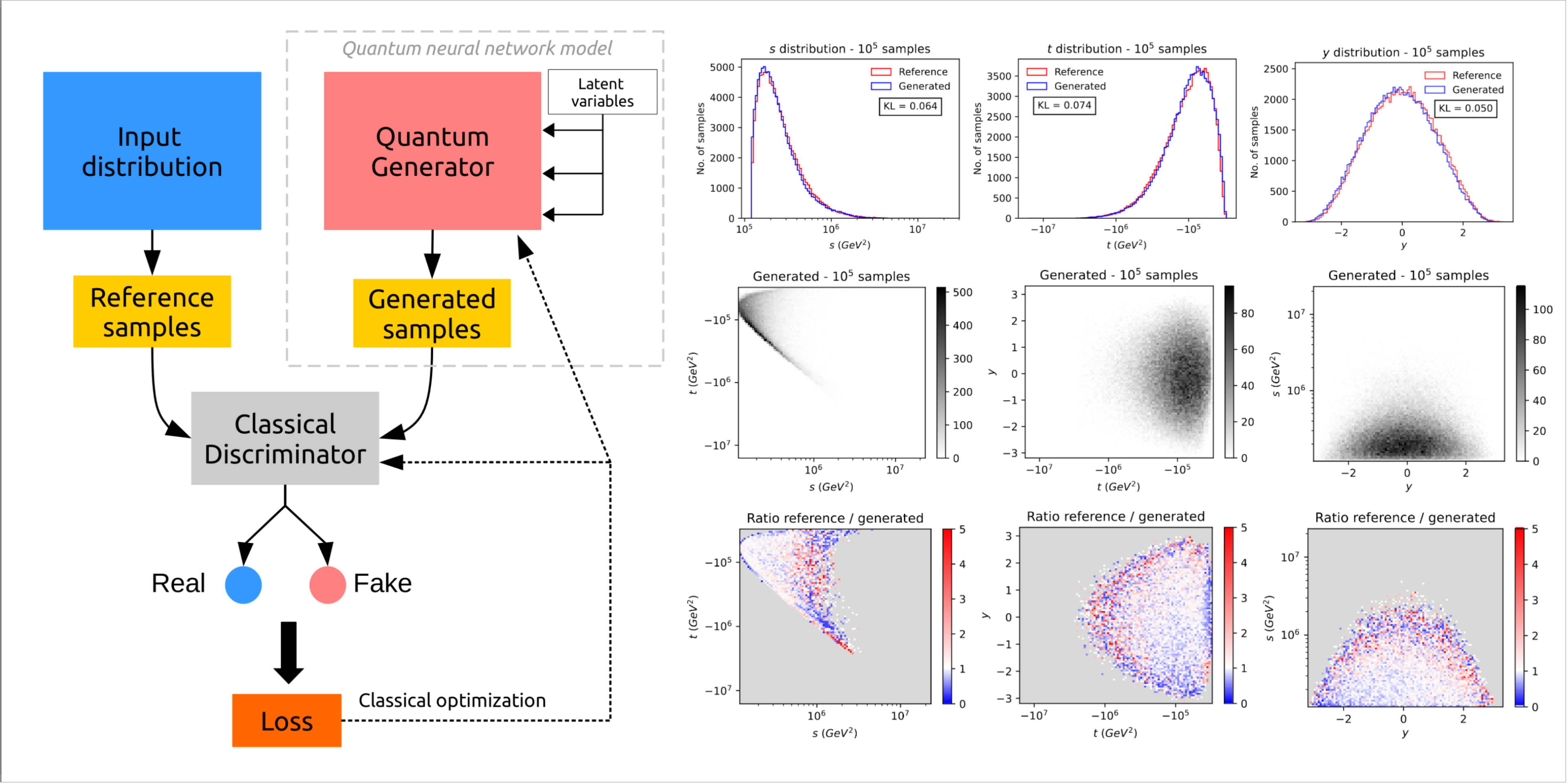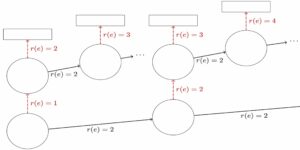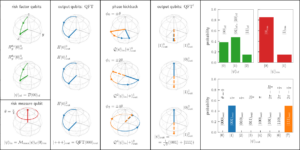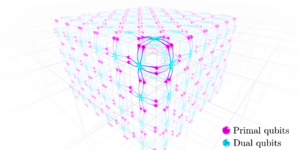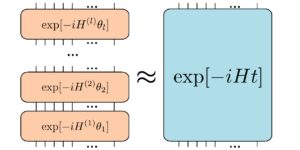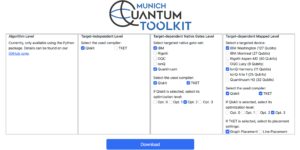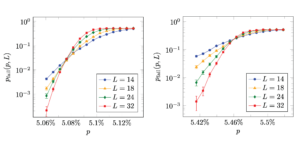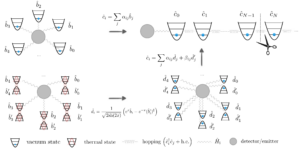1Quantum Research Centre, Technology Innovation Institute, Abu Dhabi, UAE
2Departament de Física Quàntica i Astrofísica and Institut de Ciències del Cosmos (ICCUB), Universitat de Barcelona, Barcelona, Spain.
3Theoretical Physics Department, CERN, CH-1211 Geneva 23, Switzerland.
4Institute of Physics, National Yang Ming Chiao Tung University, Hsinchu 30010, Taiwan.
5TIF Lab, Dipartimento di Fisica, Università degli Studi di Milano and INFN Sezione di Milano, Milan, Italy.
Find this paper interesting or want to discuss? Scite or leave a comment on SciRate.
Abstract
We propose and assess an alternative quantum generator architecture in the context of generative adversarial learning for Monte Carlo event generation, used to simulate particle physics processes at the Large Hadron Collider (LHC). We validate this methodology by implementing the quantum network on artificial data generated from known underlying distributions. The network is then applied to Monte Carlo-generated datasets of specific LHC scattering processes. The new quantum generator architecture leads to a generalization of the state-of-the-art implementations, achieving smaller Kullback-Leibler divergences even with shallow-depth networks. Moreover, the quantum generator successfully learns the underlying distribution functions even if trained with small training sample sets; this is particularly interesting for data augmentation applications. We deploy this novel methodology on two different quantum hardware architectures, trapped-ion and superconducting technologies, to test its hardware-independent viability.
Featured image: On the left, schematic steps involved in the style-qGAN training. On the right, marginal samples distributions for the physical observables, s, t, y in pp -> ttbar production at the LHC for the style-qGAN model.
► BibTeX data
► References
[1] J. Preskill, Quantum 2, 79 (2018).
https://doi.org/10.22331/q-2018-08-06-79
[2] F. Arute, K. Arya, R. Babbush, D. Bacon, J. C. Bardin, R. Barends, R. Biswas, S. Boixo, F. G. S. L. Brandao, D. A. Buell, et al., Nature 574, 505 (2019).
https://doi.org/10.1038/s41586-019-1666-5
[3] H.-S. Zhong, H. Wang, Y.-H. Deng, M.-C. Chen, L.-C. Peng, Y.-H. Luo, J. Qin, D. Wu, X. Ding, Y. Hu, et al., Science 370, 1460 (2020).
https://doi.org/10.1126/science.abe8770
[4] M. Cerezo, A. Arrasmith, R. Babbush, S. C. Benjamin, S. Endo, K. Fujii, J. R. McClean, K. Mitarai, X. Yuan, L. Cincio, et al., Nature Reviews Physics 3, 625–644 (2021).
https://doi.org/10.1038/s42254-021-00348-9
[5] K. Bharti, A. Cervera-Lierta, T. H. Kyaw, T. Haug, S. Alperin-Lea, A. Anand, M. Degroote, H. Heimonen, J. S. Kottmann, T. Menke, W.-K. Mok, S. Sim, L.-C. Kwek, and A. Aspuru-Guzik, Reviews of Modern Physics 94, 015004 (2022).
https://doi.org/10.1103/RevModPhys.94.015004
[6] J. Biamonte, P. Wittek, N. Pancotti, P. Rebentrost, N. Wiebe, and S. Lloyd, Nature 549, 195 (2017).
https://doi.org/10.1038/nature23474
[7] M. Schuld and F. Petruccione, Supervised learning with quantum computers, Vol. 17 (Springer, 2018).
https://doi.org/10.1007/978-3-319-96424-9
[8] N. Wiebe, D. Braun, and S. Lloyd, Physical Review Letters 109, 050505 (2012).
https://doi.org/10.1103/PhysRevLett.109.050505
[9] S. Lloyd, M. Mohseni, and P. Rebentrost, arXiv preprint arXiv:1307.0411 (2013).
https://doi.org/10.48550/arXiv.1307.0411
arXiv:1307.0411
[10] P. Rebentrost, M. Mohseni, and S. Lloyd, Physical Review Letters 113, 130503 (2014).
https://doi.org/10.1103/physrevlett.113.130503
[11] I. Kerenidis and A. Prakash, Physical Review A 101, 022316 (2020).
https://doi.org/10.1103/PhysRevA.101.022316
[12] A. W. Harrow, A. Hassidim, and S. Lloyd, Physical Review Letters 103, 150502 (2009).
https://doi.org/10.1103/PhysRevLett.103.150502
[13] M. Benedetti, E. Lloyd, S. Sack, and M. Fiorentini, Quantum Science and Technology 4, 043001 (2019a).
https://doi.org/10.1088/2058-9565/ab4eb5
[14] S. Sim, P. D. Johnson, and A. Aspuru-Guzik, Advanced Quantum Technologies 2, 1900070 (2019).
https://doi.org/10.1002/qute.201900070
[15] C. Bravo-Prieto, J. Lumbreras-Zarapico, L. Tagliacozzo, and J. I. Latorre, Quantum 4, 272 (2020).
https://doi.org/10.22331/q-2020-05-28-272
[16] M. Larocca, N. Ju, D. García-Martín, P. J. Coles, and M. Cerezo, arXiv preprint arXiv:2109.11676 (2021).
https://doi.org/10.48550/arXiv.2109.11676
arXiv:2109.11676
[17] M. Schuld, R. Sweke, and J. J. Meyer, Physical Review A 103, 032430 (2021).
https://doi.org/10.1103/PhysRevA.103.032430
[18] T. Goto, Q. H. Tran, and K. Nakajima, Physical Review Letters 127, 090506 (2021).
https://doi.org/10.1103/PhysRevLett.127.090506
[19] A. Pérez-Salinas, D. López-Núñez, A. García-Sáez, P. Forn-Díaz, and J. I. Latorre, Physical Review A 104, 012405 (2021).
https://doi.org/10.1103/PhysRevA.104.012405
[20] V. Havlíček, A. D. Córcoles, K. Temme, A. W. Harrow, A. Kandala, J. M. Chow, and J. M. Gambetta, Nature 567, 209 (2019).
https://doi.org/10.1038/s41586-019-0980-2
[21] M. Schuld, A. Bocharov, K. M. Svore, and N. Wiebe, Physical Review A 101, 032308 (2020).
https://doi.org/10.1103/physreva.101.032308
[22] A. Pérez-Salinas, A. Cervera-Lierta, E. Gil-Fuster, and J. I. Latorre, Quantum 4, 226 (2020).
https://doi.org/10.22331/q-2020-02-06-226
[23] T. Dutta, A. Pérez-Salinas, J. P. S. Cheng, J. I. Latorre, and M. Mukherjee, Physical Review A 106, 012411 (2022).
https://doi.org/10.1103/PhysRevA.106.012411
[24] J. Romero, J. P. Olson, and A. Aspuru-Guzik, Quantum Science and Technology 2, 045001 (2017).
https://doi.org/10.1088/2058-9565/aa8072
[25] A. Pepper, N. Tischler, and G. J. Pryde, Physical Review Letters 122, 060501 (2019).
https://doi.org/10.1103/PhysRevLett.122.060501
[26] C. Bravo-Prieto, Machine Learning: Science and Technology 2, 035028 (2021).
https://doi.org/10.1088/2632-2153/ac0616
[27] C. Cao and X. Wang, Physical Review Applied 15, 054012 (2021).
https://doi.org/10.1103/PhysRevApplied.15.054012
[28] M. Benedetti, D. Garcia-Pintos, O. Perdomo, V. Leyton-Ortega, Y. Nam, and A. Perdomo-Ortiz, npj Quantum Information 5, 1 (2019b).
https://doi.org/10.1038/s41534-019-0157-8
[29] K. E. Hamilton, E. F. Dumitrescu, and R. C. Pooser, Physical Review A 99, 062323 (2019).
https://doi.org/10.1103/PhysRevA.99.062323
[30] B. Coyle, D. Mills, V. Danos, and E. Kashefi, npj Quantum Information 6, 1 (2020).
https://doi.org/10.1038/s41534-020-00288-9
[31] P.-L. Dallaire-Demers and N. Killoran, Physical Review A 98, 012324 (2018).
https://doi.org/10.1103/PhysRevA.98.012324
[32] S. Lloyd and C. Weedbrook, Physical Review Letters 121, 040502 (2018).
https://doi.org/10.1103/PhysRevLett.121.040502
[33] I. Goodfellow, J. Pouget-Abadie, M. Mirza, B. Xu, D. Warde-Farley, S. Ozair, A. Courville, and Y. Bengio, Communications of the ACM 63, 139–144 (2020).
https://doi.org/10.1145/3422622
[34] C. Zoufal, A. Lucchi, and S. Woerner, npj Quantum Information 5, 1 (2019).
https://doi.org/10.1038/s41534-019-0223-2
[35] J. Zeng, Y. Wu, J.-G. Liu, L. Wang, and J. Hu, Physical Review A 99, 052306 (2019).
https://doi.org/10.1103/PhysRevA.99.052306
[36] H. Situ, Z. He, Y. Wang, L. Li, and S. Zheng, Information Sciences 538, 193 (2020).
https://doi.org/10.1016/j.ins.2020.05.127
[37] L. Hu, S.-H. Wu, W. Cai, Y. Ma, X. Mu, Y. Xu, H. Wang, Y. Song, D.-L. Deng, C.-L. Zou, et al., Science advances 5, eaav2761 (2019).
https://doi.org/10.1126/sciadv.aav2761
[38] M. Benedetti, E. Grant, L. Wossnig, and S. Severini, New Journal of Physics 21, 043023 (2019c).
https://doi.org/10.1088/1367-2630/ab14b5
[39] J. Romero and A. Aspuru-Guzik, Advanced Quantum Technologies 4, 2000003 (2021).
https://doi.org/10.1002/qute.202000003
[40] M. Y. Niu, A. Zlokapa, M. Broughton, S. Boixo, M. Mohseni, V. Smelyanskyi, and H. Neven, Physical Review Letters 128, 220505 (2022).
https://doi.org/10.1103/PhysRevLett.128.220505
[41] T. Karras, S. Laine, and T. Aila, IEEE Transactions on Pattern Analysis and Machine Intelligence 43, 4217 (2021).
https://doi.org/10.1109/TPAMI.2020.2970919
[42] A. Pérez-Salinas, J. Cruz-Martinez, A. A. Alhajri, and S. Carrazza, Physical Review D 103, 034027 (2021).
https://doi.org/10.1103/PhysRevD.103.034027
[43] W. Guan, G. Perdue, A. Pesah, M. Schuld, K. Terashi, S. Vallecorsa, and J.-R. Vlimant, Machine Learning: Science and Technology 2, 011003 (2021).
https://doi.org/10.1088/2632-2153/abc17d
[44] S. Y. Chang, S. Vallecorsa, E. F. Combarro, and F. Carminati, arXiv preprint arXiv:2101.11132 (2021a).
https://doi.org/10.48550/arXiv.2101.11132
arXiv:2101.11132
[45] S. Y. Chang, S. Herbert, S. Vallecorsa, E. F. Combarro, and R. Duncan, EPJ Web of Conferences 251, 03050 (2021b).
https://doi.org/10.1051/epjconf/202125103050
[46] V. Belis, S. González-Castillo, C. Reissel, S. Vallecorsa, E. F. Combarro, G. Dissertori, and F. Reiter, EPJ Web of Conferences 251, 03070 (2021).
https://doi.org/10.1051/epjconf/202125103070
[47] G. R. Khattak, S. Vallecorsa, F. Carminati, and G. M. Khan, The European Physical Journal C 82, 1 (2022).
https://doi.org/10.1140/epjc/s10052-022-10258-4
[48] P. Baldi, L. Blecher, A. Butter, J. Collado, J. N. Howard, F. Keilbach, T. Plehn, G. Kasieczka, and D. Whiteson, arXiv preprint arXiv:2012.11944 (2021).
https://doi.org/10.48550/arXiv.2012.11944
arXiv:2012.11944
[49] M. Backes, A. Butter, T. Plehn, and R. Winterhalder, SciPost Physics 10, 89 (2021).
https://doi.org/10.21468/SciPostPhys.10.4.089
[50] A. Butter and T. Plehn, in Artificial Intelligence For High Energy Physics (World Scientific, 2022) pp. 191–240.
https://doi.org/10.1142/9789811234033_0007
[51] A. Butter, S. Diefenbacher, G. Kasieczka, B. Nachman, and T. Plehn, SciPost Physics 10, 139 (2021).
https://doi.org/10.21468/SciPostPhys.10.6.139
[52] A. Butter, T. Plehn, and R. Winterhalder, SciPost Physics Core 3, 9 (2020).
https://doi.org/10.21468/SciPostPhysCore.3.2.009
[53] M. Bellagente, A. Butter, G. Kasieczka, T. Plehn, and R. Winterhalder, SciPost Physics 8, 70 (2020).
https://doi.org/10.21468/SciPostPhys.8.4.070
[54] A. Butter, T. Plehn, and R. Winterhalder, SciPost Physics 7, 75 (2019).
https://doi.org/10.21468/SciPostPhys.7.6.075
[55] S. Efthymiou, S. Ramos-Calderer, C. Bravo-Prieto, A. Pérez-Salinas, D. García-Martín, A. Garcia-Saez, J. I. Latorre, and S. Carrazza, Quantum Science and Technology 7, 015018 (2021a).
https://doi.org/10.1088/2058-9565/ac39f5
[56] S. Efthymiou, S. Carrazza, S. Ramos, bpcarlos, AdrianPerezSalinas, D. García-Martín, Paul, J. Serrano, and atomicprinter, qiboteam/qibo: Qibo 0.1.6-rc1 (2021b).
https://doi.org/10.5281/zenodo.5088103
[57] M. Abadi, A. Agarwal, P. Barham, E. Brevdo, Z. Chen, C. Citro, G. S. Corrado, A. Davis, J. Dean, M. Devin, et al., TensorFlow: Large-scale machine learning on heterogeneous systems (2015), software available from tensorflow.org.
https://www.tensorflow.org/
[58] afrancis heplat, C. Bravo-Prieto, S. Carrazza, M. Cè, J. Baglio, and d-m grabowska, Qti-th/style-qgan: v1.0.0 (2021).
https://doi.org/10.5281/zenodo.5567077
[59] M. D. Zeiler, arXiv preprint arXiv:1212.5701 (2012).
https://doi.org/10.48550/arXiv.1212.5701
arXiv:1212.5701
[60] M. Ostaszewski, E. Grant, and M. Benedetti, Quantum 5, 391 (2021).
https://doi.org/10.22331/q-2021-01-28-391
[61] S. Kullback and R. A. Leibler, The Annals of Mathematical Statistics 22, 79 (1951).
https://doi.org/10.1214/aoms/1177729694
[62] M. Frid-Adar, E. Klang, M. Amitai, J. Goldberger, and H. Greenspan, in 2018 IEEE 15th International Symposium on Biomedical Imaging (ISBI 2018) (2018) pp. 289–293.
https://doi.org/10.1109/ISBI.2018.8363576
[63] F. H. K. dos Santos Tanaka and C. Aranha, arXiv preprint arXiv:1904.09135 (2019).
https://doi.org/10.48550/arXiv.1904.09135
arXiv:1904.09135
[64] J. Alwall, R. Frederix, S. Frixione, V. Hirschi, F. Maltoni, O. Mattelaer, H. S. Shao, T. Stelzer, P. Torrielli, and M. Zaro, Journal of High Energy Physics 07, 079 (2014).
https://doi.org/10.1007/JHEP07(2014)079
[65] R. Frederix, S. Frixione, V. Hirschi, D. Pagani, H. S. Shao, and M. Zaro, Journal of High Energy Physics 07, 185 (2018).
https://doi.org/10.1007/JHEP07(2018)185
[66] I.-K. Yeo and R. A. Johnson, Biometrika 87, 954 (2000).
https://doi.org/10.1093/biomet/87.4.954
[67] F. Pedregosa, G. Varoquaux, A. Gramfort, V. Michel, B. Thirion, O. Grisel, M. Blondel, P. Prettenhofer, R. Weiss, V. Dubourg, J. Vanderplas, A. Passos, D. Cournapeau, M. Brucher, M. Perrot, and E. Duchesnay, Journal of Machine Learning Research 12, 2825–2830 (2011).
https://dl.acm.org/doi/10.5555/1953048.2078195
[68] G. Aleksandrowicz, T. Alexander, P. Barkoutsos, L. Bello, Y. Ben-Haim, D. Bucher, F. J. Cabrera-Hernández, J. Carballo-Franquis, A. Chen, C.-F. Chen, et al., Qiskit: An Open-source Framework for Quantum Computing (2019).
https://doi.org/10.5281/zenodo.2562111
Cited by
[1] Travis S. Humble, Andrea Delgado, Raphael Pooser, Christopher Seck, Ryan Bennink, Vicente Leyton-Ortega, C. -C. Joseph Wang, Eugene Dumitrescu, Titus Morris, Kathleen Hamilton, Dmitry Lyakh, Prasanna Date, Yan Wang, Nicholas A. Peters, Katherine J. Evans, Marcel Demarteau, Alex McCaskey, Thien Nguyen, Susan Clark, Melissa Reville, Alberto Di Meglio, Michele Grossi, Sofia Vallecorsa, Kerstin Borras, Karl Jansen, and Dirk Krücker, “Snowmass White Paper: Quantum Computing Systems and Software for High-energy Physics Research”, arXiv:2203.07091.
[2] Andreas Adelmann, Walter Hopkins, Evangelos Kourlitis, Michael Kagan, Gregor Kasieczka, Claudius Krause, David Shih, Vinicius Mikuni, Benjamin Nachman, Kevin Pedro, and Daniel Winklehner, “New directions for surrogate models and differentiable programming for High Energy Physics detector simulation”, arXiv:2203.08806.
[3] Andrea Delgado, Kathleen E. Hamilton, Prasanna Date, Jean-Roch Vlimant, Duarte Magano, Yasser Omar, Pedrame Bargassa, Anthony Francis, Alessio Gianelle, Lorenzo Sestini, Donatella Lucchesi, Davide Zuliani, Davide Nicotra, Jacco de Vries, Dominica Dibenedetto, Miriam Lucio Martinez, Eduardo Rodrigues, Carlos Vazquez Sierra, Sofia Vallecorsa, Jesse Thaler, Carlos Bravo-Prieto, su Yeon Chang, Jeffrey Lazar, and Carlos A. Argüelles, “Quantum Computing for Data Analysis in High-Energy Physics”, arXiv:2203.08805.
[4] Yuxuan Du, Zhuozhuo Tu, Bujiao Wu, Xiao Yuan, and Dacheng Tao, “Power of Quantum Generative Learning”, arXiv:2205.04730.
[5] Stefano Carrazza, Stavros Efthymiou, Marco Lazzarin, and Andrea Pasquale, “An open-source modular framework for quantum computing”, arXiv:2202.07017.
[6] Sandra Nguemto and Vicente Leyton-Ortega, “Re-QGAN: an optimized adversarial quantum circuit learning framework”, arXiv:2208.02165.
[7] Gabriele Agliardi, Michele Grossi, Mathieu Pellen, and Enrico Prati, “Quantum integration of elementary particle processes”, Physics Letters B 832, 137228 (2022).
[8] Jack Y. Araz and Michael Spannowsky, “Classical versus Quantum: comparing Tensor Network-based Quantum Circuits on LHC data”, arXiv:2202.10471.
[9] Andrea Delgado and Kathleen E. Hamilton, “Unsupervised Quantum Circuit Learning in High Energy Physics”, arXiv:2203.03578.
[10] Sulaiman Alvi, Christian Bauer, and Benjamin Nachman, “Quantum Anomaly Detection for Collider Physics”, arXiv:2206.08391.
[11] Oriel Kiss, Michele Grossi, Enrique Kajomovitz, and Sofia Vallecorsa, “Conditional Born machine for Monte Carlo events generation”, arXiv:2205.07674.
The above citations are from SAO/NASA ADS (last updated successfully 2022-08-18 08:19:35). The list may be incomplete as not all publishers provide suitable and complete citation data.
On Crossref’s cited-by service no data on citing works was found (last attempt 2022-08-18 08:19:33).
This Paper is published in Quantum under the Creative Commons Attribution 4.0 International (CC BY 4.0) license. Copyright remains with the original copyright holders such as the authors or their institutions.

